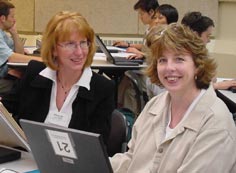
|
 |
Text Analysis: Example 1
Example of a Completed Written
Text analysis
Jill Pearson - March, 2004
Theme: Water Use
Text Title: Comment
préserver l'eau à la maison
Grade Level: 11th-12th
Language Proficiency Level:
reading, intermediate-low
to mid,
listening, intermediate-low to mid;
speaking, intermediate-low
to high;
writing, intermediate-low to advanced.
PLEASE NOTE: To see this text analysis as an integrated piece
of a lesson (and the unit), please visit Lesson
2 of Jill's unit.
Content
Key related concepts
Waste (of water), water
purification, hygiene, conservation |
Facts
- Household activities such as toilet
flushing, showing (and other hygienic activities), clothes
washing, cleaning,
and gardening use a lot of water (see text for figures).
- In Western countries, we use water that is purified to the
level of
drinking
water for tasks that do not involve human consumption of
water.
- Household appliances typically use a lot of water, but
there
are
new products that are made to save water (toilets, shower
heads, etc.)
|
Essential Understandings Requiring Pre-teaching
- People need water to live.
- People depend on water for many
activities during the day.
- Many people waste/ use excessively
water.
- People
may take water and its availability for granted.
- What's
here today may not be tomorrow.
- There are steps we can
take as
individuals to conserve water.
|
Culture
Unfamiliar cultural assumptions
Products (unfamiliar or familiar but
used in a new way)
Gardens or yards (see below)
Toilet (model pictured
in text is likely unfamiliar to American youth)
Water-conserving
appliances (according to this article, they have le label européen.
|
Practices (unfamiliar or familiar but used
in a new way)
"jardinage": gardening in Belgium, where this text
is from, would likely involve much less water than American gardening
or lawn care due to the fact that lawns are typically smaller in
Belgium and people in America water their grass more in an effort
to keep it very green, and for that matter, are more likely to
use sod than Belgians.
Using “litres” as measurement
|
Perspectives
Bigger is not necessarily better
|
Genre
Text Organization
Purpose (e.g., present information, teach
a moral, entertain, etc.)
Discussion: to evaluate an issue and
persuade another
Report: to give information
|
Text Structure (e.g., introduce setting/character,
events, problem/resolution, etc.)
Title: Identifies issue (conservation
of water at home)
Thesis: “It's important to consume water in a responsible manner and to eliminate
polluting wastes.”
Supporting evidence: Shows how much water we use for different
domestic tasks, shares figures regarding how changing habits and making changes
in appliances can conserve water
2nd statement of position: “Use a rain water well for washing, cleaning, the
toilets, washing machine, and watering your garden”
Supporting evidence: list
of advantages (economic, environmental, etc.)
|
Linguistic Features related to Genre [connectives,
(e.g., adverbs of time, conjunctions), verb type (action vs. saying
verbs), verb tense, use of dialogue, etc.]
- Inclusion through
use of "nous" imperative: choisissons, concentrons-nous,
réparons… (let's
choose, let's concentrate, let's repare…)
[NOTE: this feature
might be in conflict with the framework for linguistic features
in the
discussion genre set forth by Fortune & Tedick 2003. Nominalization
is not used to create authority and de-personalize the text;
rather, the language is inclusive and incites the reader to
join a collective
movement. Perhaps this can be explained by the fact that this
is a less sophisticated text aimed at a younger audience.]
- Connectives:
Clarifying (donc), indicating time (lors, lorsque), adding
information (ainsi)
- Conjunctions: Showing cause/effect (par
conséquent)
- Additional cause & effect language (Elle permet…, Cela prolonge…)
|
Learning Strategies and Possible Instructional Activities
Before Reading
Make personal connection to
the issue by conducting a personal investigation: chart how many
times you flush the toilet, wash hands, etc.
Activate prior
knowledge
through a discussion of their “findings.”
Make predictions both
about how much water you use and about the title and the content
of the article.
|
During Reading
Recognize and use cognates to comprehend the text.
Make inferences based on context (including pictures/use imagery) to interpret the meaning
of the text.
Use
background knowledge such as previously learned vocabulary (domestic
tasks, etc.).
Apply personal learning strategies (manage my own
learning, monitor task, use resources - ask questions)
|
After Reading
Summarize the reading and debrief
as a class.
Personalize the text and apply the information by using
the figures given to calculate how much water you used in the day
you recorded your activities.
Compare water use with classmates
through discussion (cooperate).
Take notes, making a list of linguistic
features-the different ways suggestions are made.
Classify information,
listing things we can do to conserve water that are: easy/ less
easy, inexpressive/ expensive, things I am willing to do/ things
, things I'm not willing to do, etc. (also personalize).
|
Language
Vocabulary (Words, Phrases, Idioms)
Essential vocabulary for learning the content
(CO)
Personal hygiene/domestic task vocabulary: se laver, se baigner,
prendre une douche, le nettoyage, le jardinage, activités ménagères,
la vaisselle, la chasse d'eau, domestique
Waste & conservation related vocabulary: gaspillage, préserver, réduire,
perte Other: moyenne, consommer, l'eau potable, la chasse , utilisation,
aliments,
les fuites |
Select vocabulary to review or preview (material
or activity related) (CC)
L'eau, la maison, l'environnement
economic
language: cher, le prix, coûter
|
Grammatical Structures and Communicative Functions
Essential language structures and functions
for learning the content (CO)
Functions: stating importance, making suggestions
Negation: Ne..que, ne…pas
Imperatives: infinitives as imperatives and nous imperatives
|
Select language structures and functions to
review or preview (material or activity related) (CC)
Functions: expressing obligation, making
suggestions, showing consequence (permettre de faire quelque
chose)
making predictions (je
pense que, je crois que); making comparisons: plus, moins,
aussi + adverb or
adjective,
Question forms, rhetorical questions
|
|
|



